Dimensional weight shipping calculator
Dimensional weight calculation FAQ
What is dimensional weight?
Dimensional or DIM weight pricing is a formula that carriers use to determine the cost to ship a package based on its volume. Dimensional weight pricing allows carriers to incorporate the size of the packages they ship into their pricing structure. After all, the number of packages that can fit on one truck or in one container depends as much on the size of the box as its weight.
Prior to 2015, the cost to ship a parcel was based on a very simple formula. Carriers used a table that would assign a base shipping rate for every combination of weight (1-150 lbs.) and zone (distance to be shipped). The heavier the package and/or the further it needed to travel, the more it cost to ship. This formula makes perfect sense until you think about one other factor: the fixed amount of space available in their trucks and aircraft. In 2015 FedEx, USPS, and UPS introduced a new pricing model called Dimensional Weight.
Is there a difference between dimensional weight vs volumetric weight?
Dimensional weight and volumetric weight are essentially the same concept, used interchangeably in shipping and logistics. They’re calculated based on a package’s volume rather than its actual weight. This method is used to ensure that large but light packages are priced fairly, as they take up significant space in transport vehicles. The calculation typically involves multiplying the package’s length, width, and height, then dividing by a factor determined by the shipping company.
Why dimensional weight pricing?
The purpose of dimensional weight pricing is to calculate FedEx, UPS, and USPS shipping costs factoring in the amount of space a parcel will take up and charge accordingly. The space each package occupies is at a premium, thanks to a growth in eCommerce shipping. Space has become a precious commodity.
Generally, if your package is heavy or small, you don’t need to worry about DIM prices. You’ll pay for carrier shipping based solely on the actual package weight. However, if you ship something relatively light in a large box, you may pay more than you usually expect due to DIM weight pricing.
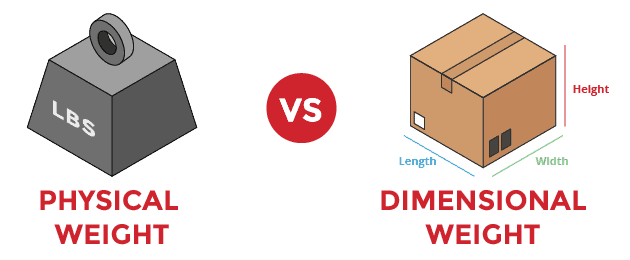
What is DIM factor?
Each shipper uses a number called the DIM factor to calculate a package’s dimensional weight. To determine the DIM weight, you’ll take the volume and divide it by the DIM factor.
UPS, FedEx, and USPS each set their own DIM factor. These companies update their DIM factors every year. In 2019, the US Postal Service changed its DIM weight pricing model to apply to all packages greater than 1,728 cubic inches. DIM weight pricing doesn’t apply to USPS flat rate shipments.
How to calculate dimensional weight?
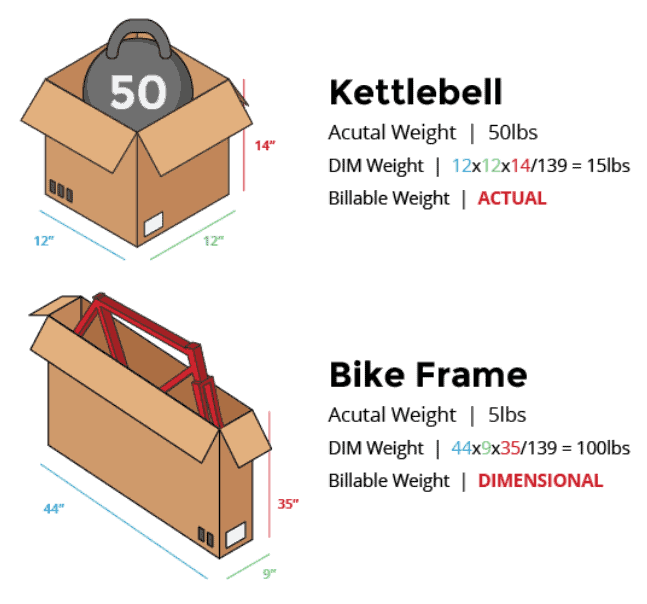
FedEx, UPS, and USPS dimensional weight formulas all follow the same basic guidelines: Determine the package’s dimensions, multiple them to get the volume, and divide the volume by the carrier’s DIM Factor.
This math will provide you with a DIM weight. The cost to ship your package is based on whichever is greater between the DIM weight and actual weight. A package with a dimensional weight of 8 pounds and an actual weight of 5 pounds would ship as an 8-pound parcel. If a package with the same dimensions had an actual weight of 10 pounds, the shipping charge would be based on the actual weight of 10 pounds.
Generally, packages that are relatively heavy and small use actual weight more often. Large or lightweight packages are more likely to use DIM weight because of their high volume. Imagine the large box for shipping a light titanium bike frame in a single piece.
FedEx, UPS, and USPS will always use the larger value between DIM Weight or Actual Weight as the final Billed Weight.
FedEx dimensional weight in 2024
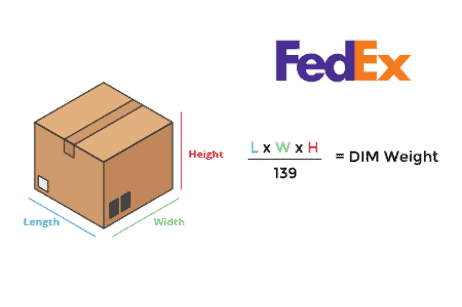
FedEx changed its DIM Factor from 166 to 139 beginning in 2017 and it remains the same today.
With the current DIM Factor, the billable weight of a 10” x 10” x 10” package is 8 pounds. (10 x 10 x 10)/139 = 8 pounds. Your FedEx shipping charges would be based on the volumetric weight of 8 pounds because that is greater than the actual weight.
FedEx has updated its base billing rates so that it uses the same as UPS. Now, for packages of the same rate, UPS has a slight price advantage in Zones 2 through 4. FedEx tends to be slightly cheaper in Zones 5 through 8.
UPS dimensional weight in 2024
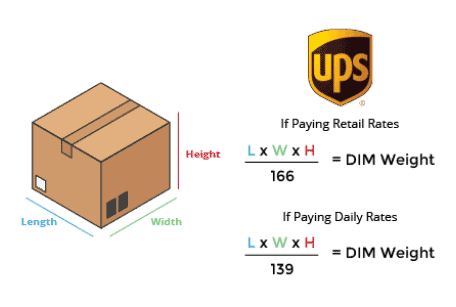
UPS has kept the same DIM Factor of 166 for shippers who pay retail rates. For shippers who pay daily rates, the UPS DIM factor is the lower 139.
Generally, a higher DIM factor means a lower DIM weight and cost.
For example, if you shipped a 10” x 10” x 10” package that weighed 6 pounds with the retail rate, your UPS DIM weight calculation would be (10 x 10 x 10)/166 = 7 pounds. You would be charged for shipping a 7-pound package because of its DIM weight.
Shipping the same package using the daily rates that most businesses pay drops the DIM factor to 139. That lower factor raises the DIM weight to 8 pounds, so your billed weight rises to 8 pounds as well.
For this package, shipping with UPS retail rates results in a lighter billed weight than UPS daily rates and FedEx’s DIM weight.
USPS dimensional weight in 2024
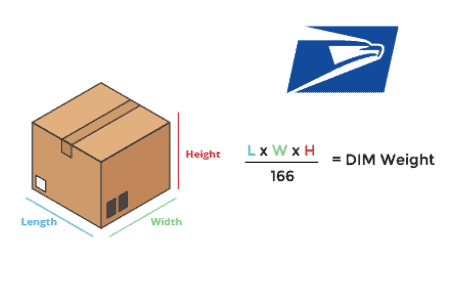
In 2019, the US Postal Service lowered their DIM Factor from 194 to 166 (the lower the DIM factor, the higher the DIM weight charges). This puts USPS dimensional weight pricing in line with UPS retail DIM pricing.
USPS still has a smaller volumetric weight penalty than most packages sent via UPS or FedEx. For example, a parcel measuring 12 x 12 x 14 would be billed at 15 pounds by both FedEx and UPS daily rates. USPS would bill this same parcel at 13 pounds. (12 x 12 x 14)/166 = 13 pounds.
When shipping with USPS Priority Mail, even packages affected by dimensional weight may not end up costing you more. The final caveat regarding USPS’s dimensional weight calculations is that they are only applied to zones 5 and up! This means that so long as you’re shipping your package relatively close by via USPS, DIM weight shouldn’t be an issue at all! USPS’s official dimensional weight calculator can be found here.
How we help clients reduce dimensional weight charges
Dimensional weight doesn’t have to drag down your sales, even if your products are large or require extra packaging. When you work with an order fulfillment company or 3PL like Red Stag Fulfillment, our volume pricing discounts can save you (and your customers) on shipping.
Order fulfillment companies ship a large number of packages with the major freight companies, so we can negotiate volume discounts and pass savings on to you. In addition to a lower rate per pound shipped, 3PL companies negotiate more favorable DIM factors that can further reduce shipping costs.
With two ways to save on shipping, your order fulfillment company can take the weight off your shoulders when it comes to sending large or bulky items.